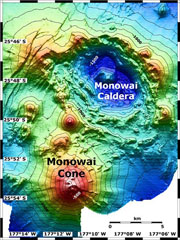Report on Monowai (New Zealand) — 8 August-14 August 2012
Smithsonian Institution / US Geological Survey
Weekly Volcanic Activity Report, 8 August-14 August 2012
Managing Editor: Sally Sennert.
Please cite this report as:
Global Volcanism Program, 2012. Report on Monowai (New Zealand) (Sennert, S, ed.). Weekly Volcanic Activity Report, 8 August-14 August 2012. Smithsonian Institution and US Geological Survey.
Monowai
New Zealand
25.887°S, 177.188°W; summit elev. -132 m
All times are local (unless otherwise noted)
According to Institute of Geological & Nuclear Sciences Limited (GNS) in a media release on 11 August, the Laboratoire de Géophysique (Papeete, Tahiti) reported that seismographs in Rarotonga recorded eruptive activity at Monowai seamount on 3 August. The activity then stopped overnight.
Geological Summary. Monowai, also known as Orion seamount, is a basaltic stratovolcano that rises from a depth of about 1,500 to within 100 m of the ocean surface about halfway between the Kermadec and Tonga island groups, at the southern end of the Tonga Ridge. Small cones occur on the N and W flanks, and an 8.5 x 11 km submarine caldera with a depth of more than 1,500 m lies to the NNE. Numerous eruptions have been identified using submarine acoustic signals since it was first recognized as a volcano in 1977. A shoal that had been reported in 1944 may have been a pumice raft or water disturbance due to degassing. Surface observations have included water discoloration, vigorous gas bubbling, and areas of upwelling water, sometimes accompanied by rumbling noises. It was named for one of the New Zealand Navy bathymetric survey ships that documented its morphology.
Source: GeoNet

